

PART FIVE (continued): Here is the history of Grangetown's pubs - those still standing and those now gone. Please email us with any stories, memories or photos. Return to Part One or Part Two
Thanks to the Grangetown Local History Society for their help.

Time, gentlemen! Grangetown's disappearing pubs
In 2025, there were just two traditional pubs left open in Grangetown. At the turn of the 20th century, there were around 14.
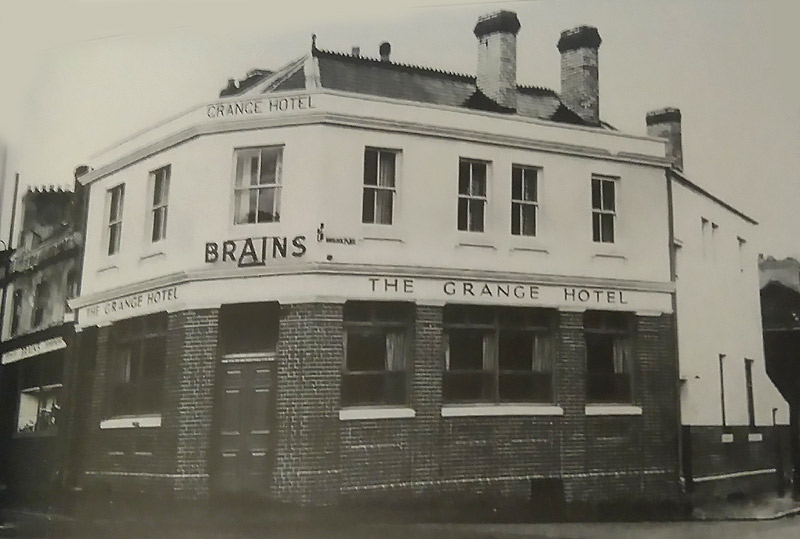
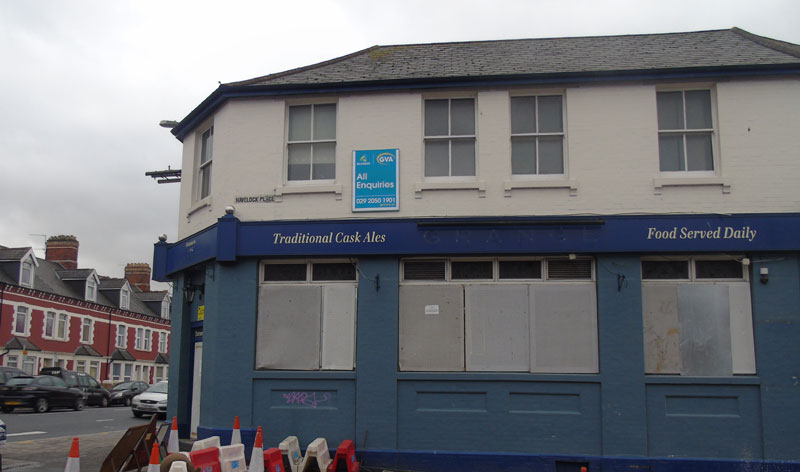
The Grange pub closed in December 2015 but re-opened in March 2017.
The Grange Inn or Grange Hotel in Penarth Road dates from the mid 1850s and is first mentioned in local newspapers and the 1858 Slaters commercial directory when it is run by George John.
By 1861, Daniel Francis, 51, ran the pub ("Grange Inn, 2 Francis Terrace") with wife Elizabeth, 54. He lived there with his carpenter son David, his wife Mary Ann, their son David; other son Thomas, 16, also living there. Elizabeth died in 1869 and Daniel, who became a carpenter and moved to Newtown, died in 1877.

By 1866, the pub was being run by James Stubbs, who also ran the local brickworks for a time. He was an engineer by training and continued trading in steam engines and iron furniture. A local paper snippet reports a "novel lamp over Mr Stubbs' door at the Grange Inn, attracts a great deal of attention" - it was described as a big barrel with a full moon stuck in each end and a blazing star in the bung hole. Next to the pub was a deep ditch and no fence at that stretch of road, so it proved useful in showing passers-by the way. Stubbs also installed a steam organ into the lounge to provide nightly musical entertainment. By 1871, his widow Sarah Stubbs - who had lived in the brickyard house near the pub 10 years before - was publican, 52, (Llanelli born, living with daughter Sarah Hughes and sons William, 21, and John, 17, Cardiff-born Cuthbert, 14 and grandaughter). George Last, who ran a pub at 41 Frederick St in 1871 - roughly where the St David's shopping centre off Queen Street is now, was running the pub by 1876 but retired in December. The advert above shows the sale of his furniture - and horse.

This map above dating from 1880 - with the pub highlighted - shows the present day Havelock Place then an unnamed Francis Terrace on the corner of Penarth Road. The original pub on the site no longer exists and was only the extent of where the current bar is now. The present lounge was actually a butcher's shop to begin with.
By 1881, Charles Day was running the pub, aged, 63, living there with his sons Harry and James, both shipwrights. Day had run in the 1870s, the Clyde Arms in modern
day City Road in Roath. Then by 1885, Mary Ann Day (nee Williams) is publican. She married Harry (shipwright in 1882 but he died in May 1889 aged 44). In the 1891 census, she was living there with her father-in law Charles and two children. She is more than likely the same Mary Williams, barmaid, 22, who was living in the pub in 1881. Then there were two sudden deaths: Charles died in August 1891, while Mary herself died at the pub aged just 33 on December 17th 1891 from cirrhosis of the liver, leaving two orphaned children Henry, 7, and Anita, 3. The youngest girl was adopted by a couple in Roath.
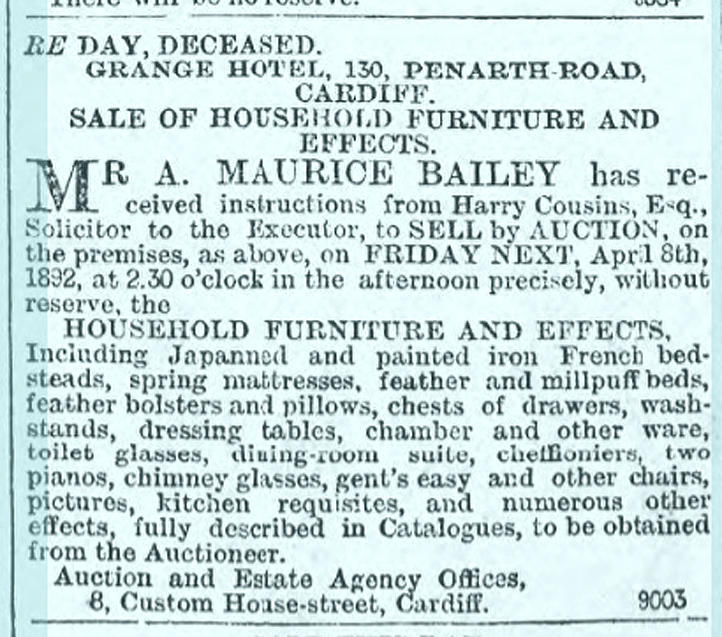
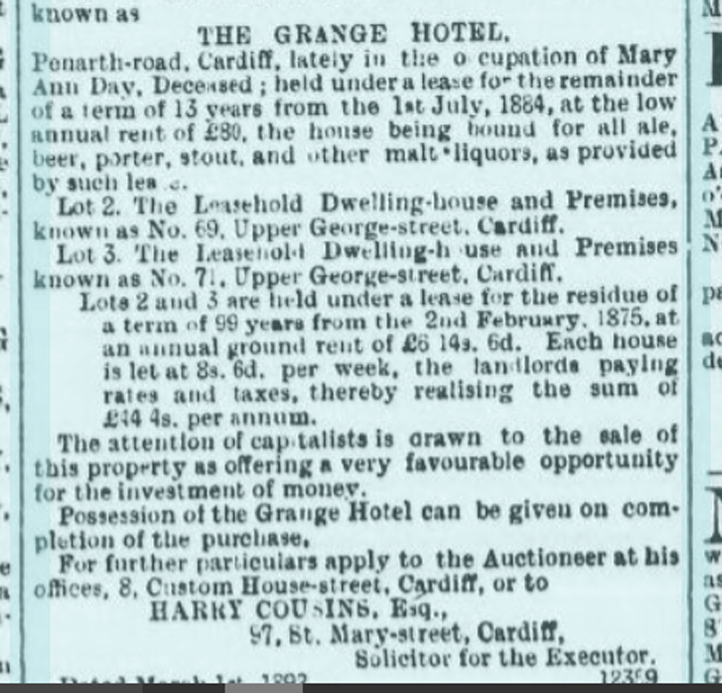
The adverts above show the sale of effects. It looks like she might have owned two houses in George St too. Mary Ann left £1,100 in her will after a sale of the pub at 130 Penarth Road, two other properties and later of furniture and other goods in the auction. The pub was sold for £810 to John Martin Pritchard with the remaining 13year lease and a rent of £80 per year. He quickly turned his hand to rebuilding and extending the pub - and would run it for the next 30 years.

The two upper storeys planned at one point. Image with permission of Glamorgan Archives.
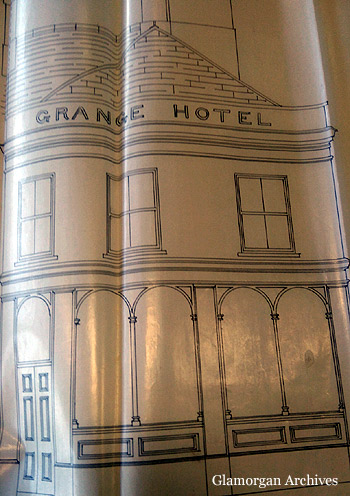 The pub was completely rebuilt in 1892 by Pritchard. Two sets of plans were submitted - one would have involved the "new" pub being three storeys high, with seven bedrooms - presumably to operate as a travellers' hotel as well as a pub. In the end, a smaller two-storey redevelopment was the one decided upon and they were accepted by the town's works committee in October 1892.
The pub was completely rebuilt in 1892 by Pritchard. Two sets of plans were submitted - one would have involved the "new" pub being three storeys high, with seven bedrooms - presumably to operate as a travellers' hotel as well as a pub. In the end, a smaller two-storey redevelopment was the one decided upon and they were accepted by the town's works committee in October 1892.
These plans were prepared for a Mrs E A Collins - possibly Elizabeth Collins, whose husband was a pub landlord in town. The smaller size of the original pub is obvious from the map above. Notice also, the Baroness Windsor pub along Penarth Road and the Penarth Dock pub in Thomas Street.
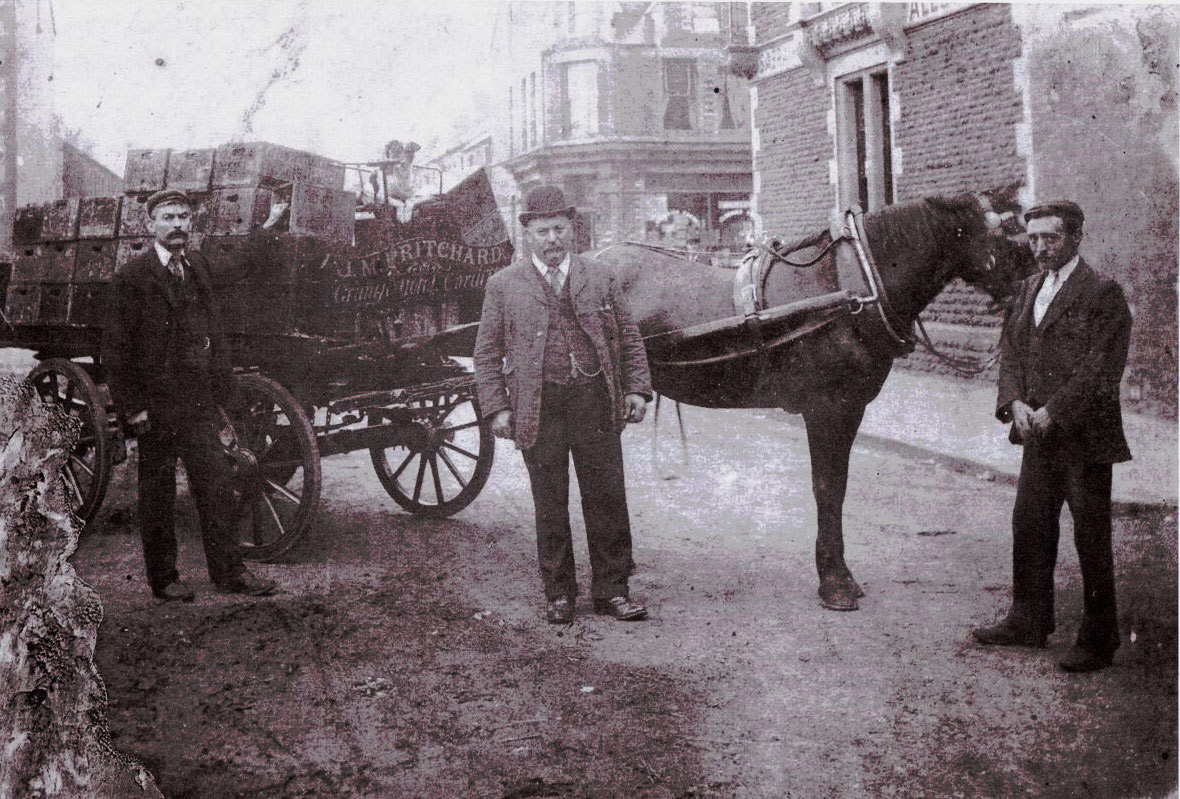

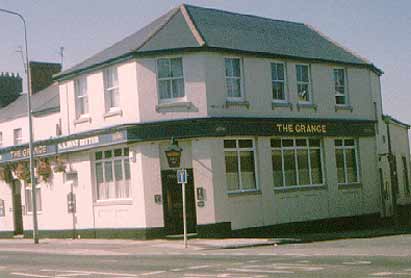
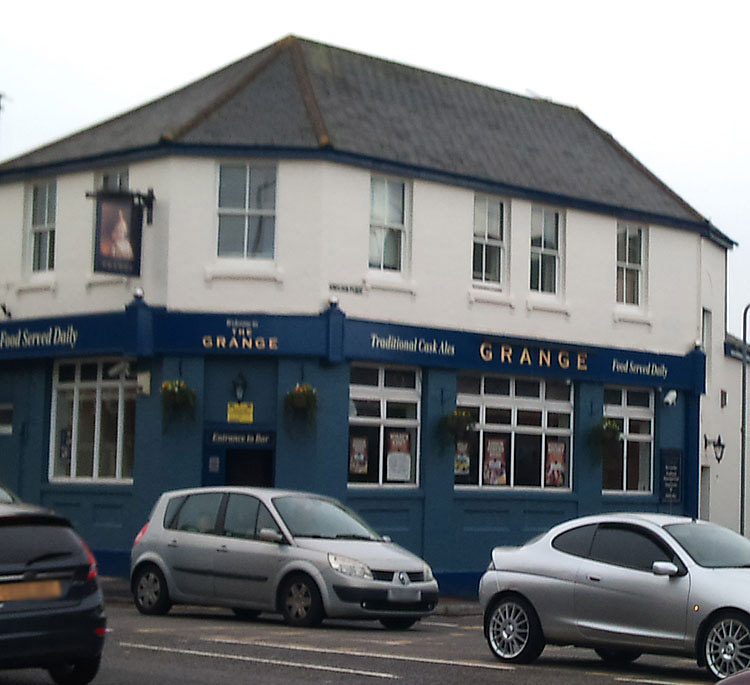
He may have been an absentee landlord in the early days. Apart from Mrs Collins mentioned (in 1892), a man called Richards was reportedly running the pub in May 1893 (mentioned in a court report, in which a 12-year-old bought whisky there). By September, Pritchard is landlord and the "structural alterations, enlargements and improvements" have been completed because he is applying for a renewal of the licence. By this time, the pub "and adjoining cottage" are mentioned in the public notice as being owned by S A Brain and Co. A month later, Pritchard is chairing a meeting at the pub of local people about the "telegraphic inconveniencies" of living in upper Grangetown and not having the wire available at Grangetown post office. This is the late Victorian equivalent of not having decent broadband!
By 1901, the census shows Pritchard then 40 and born in Llangattock, who lived there with
his second wife Ellen, 27, originally from Swansea. His son Edgar, 18, was a plumber
and there were two daughters Winifred, 11, and one-year-old May. Also living on
the premises was book-keeper Kate Jenkins, a Irish-born widow, 39, barmaid Rose
Bernard, 24, servant Emily Brooks, 23, and Mr Pritchard's cousin Ralph, 16, a
sign-writer from Monmouth. The Pritchards lived there until the 1920s. There was another refurbishment at The Grange in 1922, when new toilets were installed - in part of what had been a wine store near the back of the pub.
The plans show the pub lay-out of the original bar area, familiar to those who know the pub now; where the modern lounge is now was split into three: a "jug and bottle" area (for serving take-out alcohol), a "luncheon bar" and a smoke room at the back. Outside at the back of the yard was a stables and harness room for the horse. There was also a downstairs sitting room, kitchen and scullery for the licencee.
Pritchard
died in 1925 leaving more than £13,000 in his will. 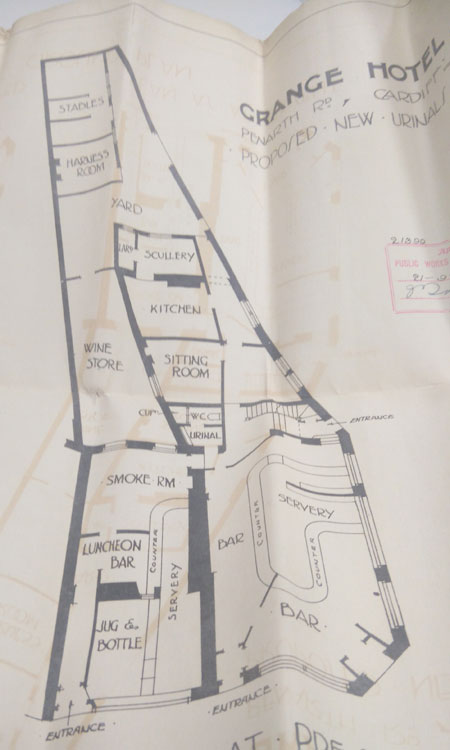

The plans in 1922 show the lay-out of the pub downstairs, with toilets to be built. Click on the image below for a larger version. With permission: Glamorgan Archives.
The pub saw further structural changes from the 1970s - the chimneys were removed; the pub lounge extended into the neighbouring butcher's shop, after the owner sold up; the off licence between the bar and lounge went in further alterations. The Grange had further landlords including for extended periods Syd Trickett, Gary Amos and Terry Wake. Fast forward to 2013: The pub closed temporarily in November and then nearly two years later the for sale signs went up. Within weeks it closed its doors. But despite fears it would be redeveloped, the owners of the successfully-reopened The Lansdowne in Canton bought it from Brain's and opened it again as a freehouse in March 2017. It has since thrived as a real ale pub, serving good food, with a regular series of events. The owners landscaped the beer garden and also tastefully converted the old skittle alley into an extra bar.
The Grange pub records in our archive

A page from the receipt book showing a sale of stout to a house in Penhaved
Street in 1914/15.
We have an archive of material belonging to John Pritchard. It is in a delicate condition but was saved by a former landlord of The Grange pub and passed onto us for curating. Pritchard was the landlord of The Grange at the turn of the century and into the 1920s but had wider business interests, including property. It included The Craddock Hotel, which once stood in Eldon Road (now Ninian Park Road) in Riverside. He also once owned a pub in Cwmbran. His receipt book, found in the roof of The Grange, included many Grangetown customers. The Craddock was owned by Brain's and built on the old Craddock Wells estate in about 1888. Pritchard left a sizeable fortune of more than £13,000 in his will when he died - around £700,000 in today's money. There are reports also of his generosity - he paid for communal Christmas lunches for the elderly and unfortunates of the area.
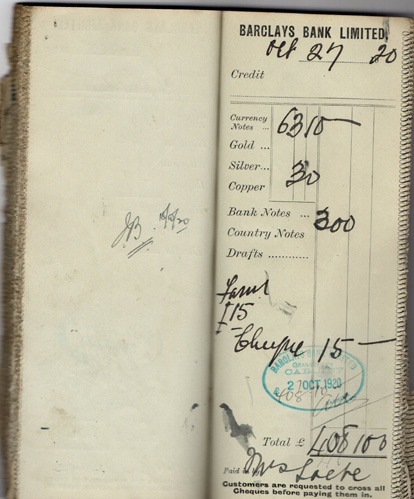
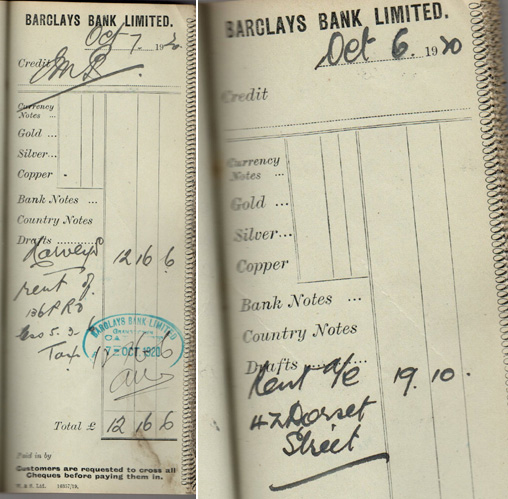
Receipts from Barclays Bank show money paid in, including rent from houses.
The last Brain's pub standing

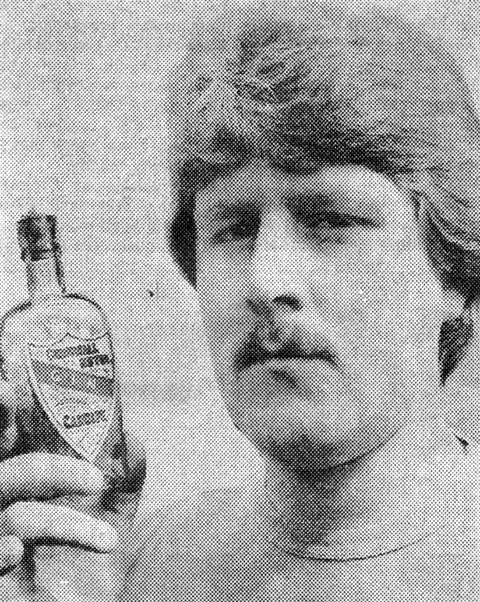
The pub in the 1980s and a bottle of Cornwall Hotel Gin, dating from the early 20th century.
For a little while, the last remaining traditional pub open was in Cornwall Street. The Cornwall (House) Hotel
- which first opened its doors on September 4th 1894. Cornwall Street itself
was built in 1888, with the streets around it being developed over the next
decade. Attempts to open the pub first started in 1889, with the idea of connecting two houses together on the corner. There was already considerable demand from the new residents of Saltmead. The pub seems to have tried to take the name Saltmead Hotel initially
when it was first built for £2,000 in 1893, with a large club room, four
public rooms, bathroom "and every convenience" It didn't initially
get a licence, although there was demand for it, given the numbers moving into the area. Evidence to the (unsuccessful) licence hearing was that
in 1885 there were no houses in the area, but by 1893 there were 786 with an
estimated population of 4,716 and "a great many houses were in the course
of erection." Giving evidence, a Joseph Hardy of Hereford Street bemoaned
the fact that on Saturday nights in the crowded Neville Hotel down the road
"there was no time and not enough room" to fill jars with beer "for
the Sunday consumption." It was put that the pub was needed to combat the
illegal drinking dens, the shebeens in the area. Finally, it was given a licence
in September 1894, despite the objections of a local vicar, the Cardiff and
district temperance federation and the landlord of the Neville down the road!
A petition of 400 local people wanting the pub to open was discounted
by the magistrates, but they still gave it the go ahead finally.
In the early days, it had its problems. The landlord George Williams was convicted
for allowing drunkeness and drinking after hours - his domestic life also made
the papers, after he fought a divorce suit from his wife, who alleged cruelty,
while he claimed adultery by one of his barmen! By 1901, it was run by Devon-born
man, Joseph Martin, 32, his wife Emma, 34, who had recently moved to Cardiff
from London with their young family and took over the licence in 1898. Also
living at the pub in 1901 was an Irish housekeeper, a widow, and two barmaids
(who also spoke Welsh) from Maesteg and Taibach. As well as family accommodation
on the first floor, there were four bedrooms upstairs - three for the use of
travellers. The licence had transferred the following year and in 1902 the pub
also dropped the "House" from the title and just became known as The
Cornwall Hotel.
The pub in 1902 had two bars, a dining room and "jug and bottle"
compartments. Plans also show there was also a separate women's snug - where part of the front bar is now - and originally a garden at the back. In 1911, it was run by James White, 50, his second wife Laura
and his 22-year-old daughter, all originally from Bath. They had four servants
living in helping to run the place. The old story about this pub is that it
is haunted by Will The Pig, the father of an old landlord who died in the lounge.
The Cornwall saw its separate bar and lounge given a more open-plan feel with
a refurbishment in 1999. More photos and memorabilia relating to the HMS Cornwall
ship, with Cardiff connections, have been added over the years.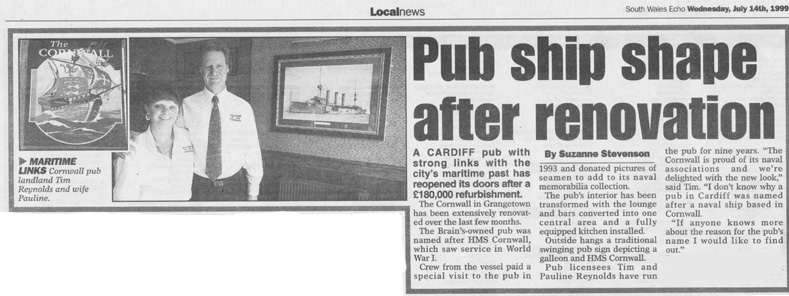
An Echo cutting telling how the pub was refurbished in the late 1990s.

The Cornwall in the late 1990s
The Cornwall today - with a slight historic tint - 120 years after it opened
Grangetown pubs no longer with us
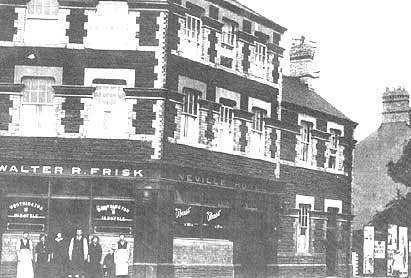

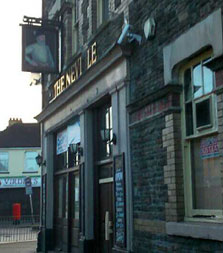
The Neville pub - probably in around 1910. And more recently
The Neville
in Allerton Street, finally closed its doors in late 2013 after several years
of doubt and a short-lived renaming - The Poet's Corner. It was turned into a
shop and flats in September 2014, exactly 125 years after it opened in 1889. It
started life as the Saltmead Hotel when it was built for the Hancock's
Brewery, before its change of name within about a year. In 1901, it was run by
Devonian John Gillard, 57, assisted by his son George, 20. His wife Annie, 51,
looked after their other five children - although the two eldest girls were an
apprentice milliner and dressmaker (so much for the myth that women didn't
go out to work..! You can easily find women who worked as laundry workers in this
area too). The pub by the time of the 1891 census was run by a Bristol man,
who lived there with his wife and six children. It had a bar, tap room, saloon
bar, and two jug and bottle compartments. It had seven bedrooms but no rooms recorded
for guests. In the photo above, the name of Walter Rheinhold Frisk appears in
large letters above the door and it is probably him in the photo with his family.
In 1911, he was the landlord of The Lansdowne pub in Canton. He was the son of
a Swedish-born greengrocer living in the Docks.
The Neville became the centre of an emergency in January 1895, when a well-known
local rugby player drowned and two other men were rescued while falling through
the ice skating on the frozen ponds the other side of Clare Road. Mr Gillard
looked after the injured. In 1911, it was run by Surrey-born Henry Haynes, 47,
and his wife Elizabeth, with five others living in to help run the pub.

The old Neville being turned into a shop and flats in 2014
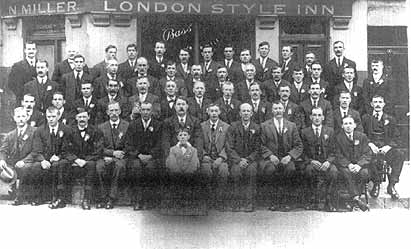
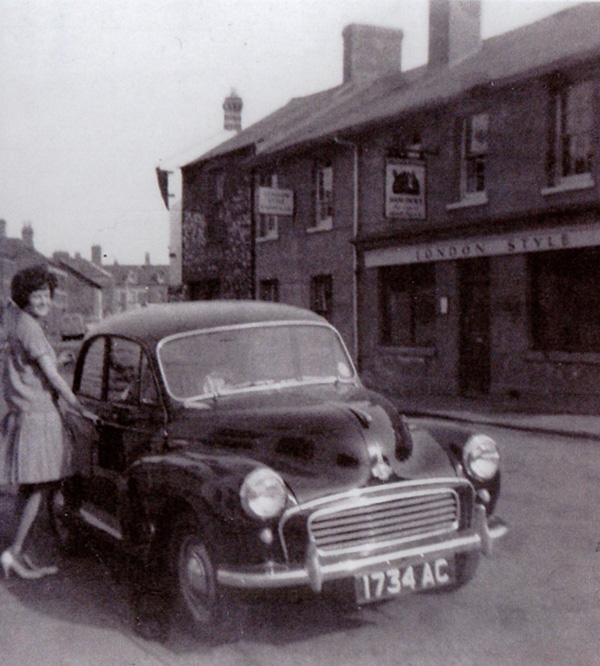
Pictured above is The Cork Club's picnic day out in 1919, outside The London Style Inn, which stood opposite St Patrick's church hall and had strong Irish links. Before the permanent church was built, it was also often used for Catholic services. It was at No 1 Lucknow Street, at the back of Havelock Place and Madras Street - both street and pub disappeared for the grounds of the modern-day St Patrick's school. I presumed the "Cork Club" was purely connected with the area's Irish community. But it was a "brotherhood", with a set of rules centred around all members having to carry a cork with them - if they were unable to produce one at the request of a member, they were asked to pay into the fund, which went to charity! "Cork Club" rules also included addressing members as "Brother."
Local historian Brian Lee wrote about the pub in his Echo column, which
quotes from a 1927 Evening Express article which said the pub used to be called the Cork
and Kerry Arms, but was renamed London Style after a grand refurbishment. There is a mention of a licence for the pub in 1872. In
1881, the pub was run by Abraham Brown, 59, a Cornish carpenter who lived there
with his wife and six children. He had worked as a ship's carpenter in the docks
since the 1860s and took over a pub in Sophia Street in the 1870s. In 1911,
the pub was run by a Nicholas Miller, 35, who lived there with his wife and
four sons. Owned by Hancock's brewery, the pub - left standing on its own - was closed and finally demolished in the early 1970s during the "slum
clearances", which had also seen Lucknow Street, Madras Street and Thomas Street
all razed. The brewery had the pub, and three houses it owned, compulsorily
purchased for £45,000 by Cardiff Council.
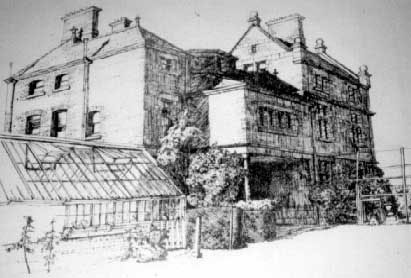
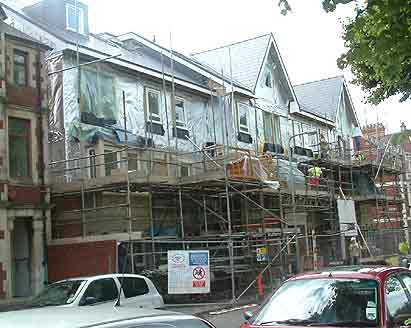
Turner's House on the embankment, and then
in the change photo (left), when it was converted into a public house; the photo
on the right is of the new flats being built in its place in 2009. Cadw did
not believe the building was worth preserving because of the changes made in
1974 - but it still seems sad to see this distinctive building disappear, especially
as it was once the house of a man behind some of the city's most beautiful structures.
At one time it was a popular venue for blues, rock and jazz bands. The association's
plans include one, two and three bedroom apartments.
The inn started life as a town house owned by William Turner - part of the
E Turner and Sons building company, which was based in Havelock Place - and
included a tennis court before being turned into a pub in 1974 by his grandson.
Turners was founded in 1885 by Ephraim Turner, 43, a Herefordshire-born mason
who had settled with his wife Anne in Merthyr Tydfil. With two of his sons James
and William, the company became associated with building Cardiff's finest Edwardian
civic buildings, including City Hall (1905), the law courts, the main University
College building (1909), as well as the Coal Exchange (1911), the David Morgan
store and the Guildhall in Swansea. Ephraim moved his family to Jubilee Terrace
in Penarth Road, when the company was first founded, before he and James moved
to Roath Park. Ephraim died in 1911 but the family continued to be involved
in the business up to the present day, although it has been taken over by a
larger firm. See
also Blitz and Blight
 The empty Inn On The River, hit by arson
attacks in June 2006, was demolished in September 2008 and a new flats development
has replaced it. Its history is only comparatively fleeting as a pub but it was
an interesting landmark all the same.
The empty Inn On The River, hit by arson
attacks in June 2006, was demolished in September 2008 and a new flats development
has replaced it. Its history is only comparatively fleeting as a pub but it was
an interesting landmark all the same.
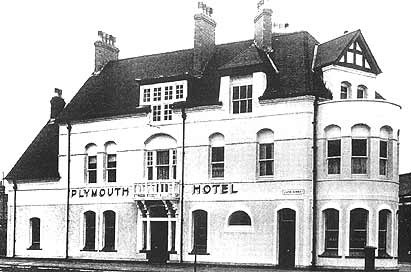
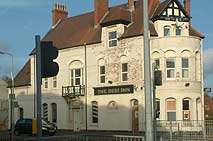
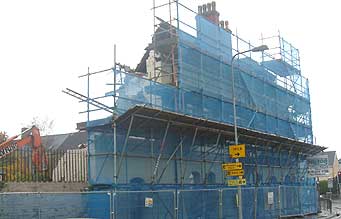

The Plymouth through the ages, and to its demolition and redevelopment.
The Plymouth, which was thought to be Grangetown's oldest pub, was demolished in November 2008. Despite some reports to the contrary that it might have opened as early as 1847, it actually dates 10 years later than that. On the corner of Clive Street and Holmesdale Street, it had a bar, tap room and smoke room, two jug and bottle compartments and nine rooms for travellers in its hey day.
It was a landmark pub as Grangetown grew up around it. The hotel was also host to meetings and dinners in Victorian times, ranging from organisations and fellowships like the Foresters and the Oddfellows, as well as the Grangetown Primrose League, the Grange Estate Tenants and until their first club was built opposite, Grangetown Conservative Association. Inquests were also held here at times. The corner public bar suffered bomb damage in January 1941, which left the room closed. Plans around this time also show a "ladies room" - a separate drinking area for women. Sadly, it was empty for several years before its demolition and the site was redeveloped for flats in 2010.
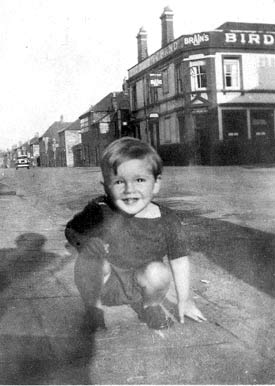
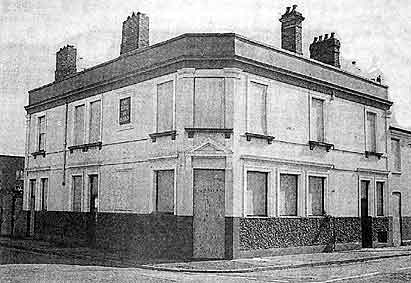
The Bird In The Hand in Bromsgrove Street,
which closed in 1995 and was demolished for development. It had two bars, smoke
room and two jug and bottle compartments. The licence in 1898 stated that as well
as selling liquor, the pub also provided "ordinary refreshments (cold) and
Bovril!" The lovely picture above is of Ken Lloyd, a late member of Grangetown History
Society, as a boy outside the pub in 1931, while next to it is a photo when it
was boarded up before demolition. At one time the pub was run by a landlord called
Mr Clark, who was related to the singer Petula Clark.
The Lord Windsor was at 47 Holmesdale Street, near the Sevenoaks Street
junction. It closed in the early 2000s.

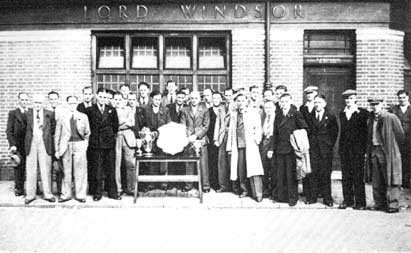
The Lord Windsor pub in Holmesdale Street in the 1950s. Women were only allowed in the snug in the years before then. This photo from Gloria Williams shows Liz, Maggie, Gloria, Muriel, Violet, Mabel, Violet, Lil and Rhoda. On the right is a club outing from the pub in 1946.
Other pubs no longer around are the Penarth Dock at 35 Thomas Street. Grangetown-born Paul Flynn MP writes of his mother Kathleen being the daughter of landlord John. The pub was a short stagger from the Baroness Windsor. There was a bar, smoke room, tap room, a quite large club room and a jug and bottle compartment. Sadly we've not come across a photo of this pub. It was compulsorily puchased in about 1967 and demolished as part of the street's redevelopment. Dan O'Neil, veteran columnist of the South Wales Echo remembered the pub was known locally as Nick Miller's after the landlord who ran it. "They'd gather around the plonking piano, bellowing their way through that week's top 20 on Radio Luxemburg," he wrote of typical Saturday evening entertainment. "And here they pioneered the sound effects for Frankie Laine's famous Mule Train. Nothing technical - just a tin beer tray clanging against their head."
The
Forge Hotel/Inn in Oakley Street (pictured above), which is thought
to have opened in the 1880s. Its building may date from the 1860s. The pub and
terrace around it was demolished in the 1970s, which these photos date from.
It had two bars, a smoke room and two jug and bottle compartments. The street
is now more modern developments.
There was also the Princess Royal at 53-55 Hewell Street, run for
a time by Robert Bryant (1870s) before he leased out the inn. The pub lost its
licence in 1891 after a police raid found drunken behaviour, and the fall-out
led to a long and costly legal dispute which ended in the highest courts in
the land as Mr Bryant, and eventually his estate after his death, fought out
a contractural dispute with brewer's Hancock's, who'd leased the pub.
Another pub to disappear more recently is the Red House on the waterfront
at Ferry Road (left). The distinctive looking pub sadly made way in 2005
for characterless apartments near the sports village. It was formerly known
as The Penarth Railway Hotel, which pre-dated 1878. It consisted in 1900
of a bar, tap room and smoke room and stables.
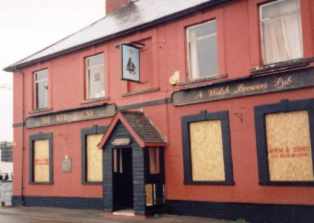
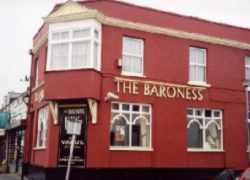
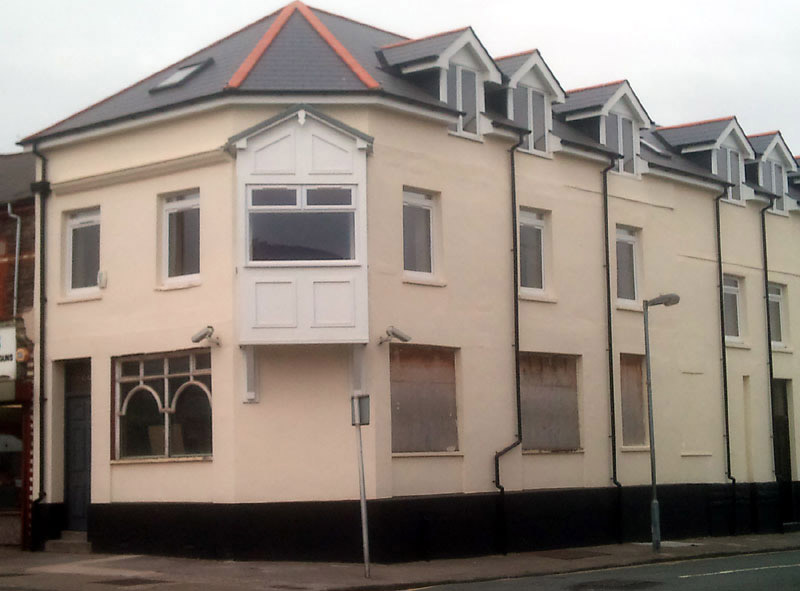
The Baroness Windsor, one of Grangetown's oldest surviving pubs until it closed in 2008, was converted into flats by 2012.
The Baroness Windsor in Penarth Road (named after Lady Windsor) by early 2008 was closed and boarded up. Another sad note in the decline in the pub trade, it was opened, like its neighbour The Grange, in 1857. In 1891, the Baroness Windor Hotel was run by a Devon-born widow called Jane Howard. There was a planning application to demolish it, but at least the new owners wanted to keep the building. The top of the pub was converted into flats but the downstairs pub has been empty for years and in 2025 was finally being converted into flats too.
Strictly jazz and jive, until 10pm
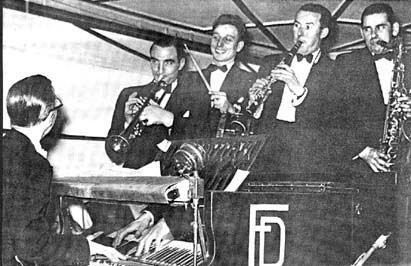
Entertainment from a dance band at the
Regent Ballroom in Maerdy Street. It later became the Irish Club in the 1980s
before being taken over by the Hindu temple and its eye-catching domes.
BY JACK PAYNE
For some years ballroom dancing has been on the decline until the introduction
of Strictly Come Dancing programme on BBC1, since when there has been
a resurge in interest. It was not so in Grangetown in the 1940s and 1950s when
regular dances for 14 to 18 years olds took place every evening of the week
except Sundays. I wonder how many of your older readers will remember this?
I am referring to dances at “The Dyke” St Dyfrigs Church hall, which took
place Monday, Wednesday and Saturday, and those at “The Stute” Grangetown Institute
Hall, Amhurst Street. Lane which took place Tuesday, Thursday, Friday and Saturday.
Mr and Mrs Jackson with the assistance of their two teenage daughters Mavis
and June and their son John ran both dances. One of the daughters subsequently
married Joe Erskine, the well known Cardiff boxer. I was introduced to the dance
at The Dyke by my school friend Calvin “Otto” Pratt, when I was 14. The dances
opened at 6.30pm and closed at 10pm sharp. No admittance was allowed after 9pm.
A gramophone operated by a man named Len provided the music. The dances were
very well attended with boys and girls travelling from all over Cardiff to attend.
I personally remember some coming from Ely, Fairwater and Penylan with the closure
at 10pm allowing them to catch a bus back home. I do not know of any other area
of Cardiff operating similar dances for this age group, except for the Pavlova
at Canton which only opened Saturday afternoon.
The boys and girls attending The Stute were more likely to have come from
the Docks and Adamstown areas. The windows of the halls were blacked out and
the only light source were coloured fairy lights around the walls, giving the
room a very warm and cosy atmosphere. Not many boys and girls had gramophones
in their homes and this was a way of keeping up with the latest records of the
day both in popular music and jazz. The Jacksons purchased new records weekly
and you could be sure that if a new record was heard on the radio it would soon
be played at the dances.
The latest jazz records were a popular talking point amongst the boys, moreso
than the other records. Entry to the dance cost sixpence and there was an adjoining
room where lemonade and crisps could be purchased. Although the dance hall opened
at 6.30pm the majority of youngsters didn’t arrive until 7-30-8pm. Those who
wished to learn to dance properly arrived early and would be taught by Mrs Jackson.
She was a very friendly lady and a very good dancer, as were her daughters.
The eldest of her daughters with a partner named Bruford took part in ballroom
dancing competitions. In the early part of the evening Mrs Jackson would not
allow you to sit out any dance but would take you to the floor herself or instruct
her daughters to dance with you. Each taking the male or female part depending
on whether they were teaching a boy or girl. For the first hour the dance music
followed a strict pattern. Quick step, followed by a slow foxtrot followed by
a waltz.. Once the hall started to fill up other dances were introduced and
every third dance would be a jive.
Many immigrants had arrived in Cardiff from the West Indies some youngsters
having jumped ship at Cardiff docks. They brought with them a type of jiving
not seen before but now being copied by our lads. When a particularly good jiver
was performing other dancers would gradually make room, forming a ring around
the floor leaving just one or two to continue whilst they clapped. Len on the
records would notice this and put the needle back on the record to make it play
longer. It wasn’t long before Cardiff Jazz Club was formed with jiving contests
taking place. As the evening progressed one could see pairs cuddling together
in the dark corners of the room. Over the several years the dances were operating
many long term relationships were formed between boys and girls with some resulting
in engagements. I wonder though how many lasted after the enforced separation
which eventually took place when the lads were called for their National Service?
© Grangetown Local History Society and webmaster 2025